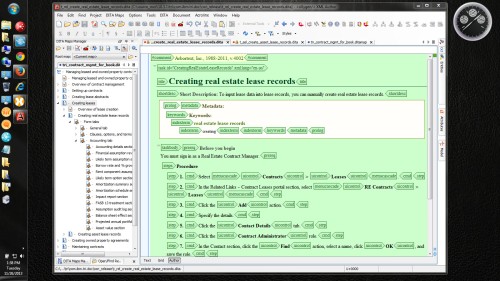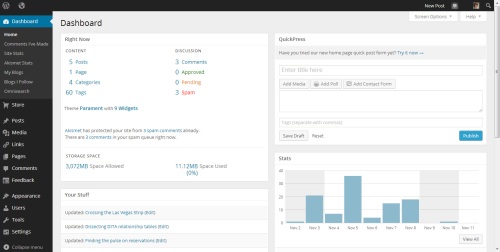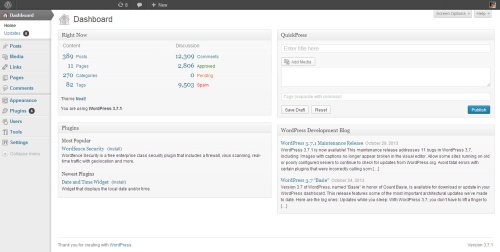As the conventional notions of desktop DITA-XML editing are being challenged more and more by social-media ideas of editing content anytime and anywhere, I’m beginning to see a growing wave of web-based and mobile-friendly XML editors. Back in December 2013, the Wikipedia article that compared 28 XML editors found only 2 web-based options: XmlGrid and FontoXML.
But in January 2014, the same article compares 29 XML editors with 3 web-based options: Xeditor, XmlGrid, and FontoXML. To confirm this, I viewed the article’s revision history, and verified that Xeditor was indeed added to the list this month in January. Meanwhile, as a fourth option, SyncRO Soft is planning to release its own oXygen web-editing platform sometime later in 2014.
Hi, my name is Jay, and I’m an IBM TRIRIGA information developer at IBM. Building upon my previous posts on killing XML and mobilizing IBM TRIRIGA, I’d like to explore the next evolutionary step for XML editors: SaaS delivery. Or perhaps I should frame it in the form of a question: Will the next evolutionary step for web-mobile XML editors be SaaS delivery?
Why SaaS?
In a previous post on mobilizing IBM TRIRIGA, I admired the dual SaaS-plus-mobile approach.
- Mobilizing IBM TRIRIGA on mobile (30 Nov 2013)
As a subscriber of Netflix SaaS streaming, if you own a computer with a web browser, then you don’t have to worry about buying or renting physical DVDs or using DVD players anymore. Also, if you own a tablet or smartphone with the Netflix mobile app, then you don’t have to worry about watching solely on a web browser either. Like I mentioned earlier, you can simply sign in, stream the content on either your web browser or mobile app, and enjoy the show.
Similarly, by subscribing to an IBM TRIRIGA SaaS solution, you don’t have to worry about installing, implementing, or maintaining the application servers, database software, and other software components on your physical infrastructure anymore. Also, by integrating an IBM TRIRIGA mobile solution, you don’t have to worry about performing tasks solely on a web browser either. You can simply sign in, perform your real estate or facilities tasks on either your web browser or mobile app, and sign out…
From my personal perspective, one challenge that I see for IBM is that its business partners are leading the way in providing both IBM TRIRIGA SaaS and mobile solutions. To be clear, SaaS and mobile don’t necessarily require each other to address a business need, but when offered together as Netflix has done, the results can be extraordinary. Naturally, I’d like for IBM to release its own IBM TRIRIGA SaaS and mobile solutions, offer them together, and enjoy the same impressive results.
In other words, with the necessary in-house or third-party cloud-hosted resources, a web-based XML editor can take advantage of the SaaS-delivery model, so “you don’t have to worry about installing, implementing, or maintaining the application servers, database software, and other software components on your physical infrastructure anymore.” But there’s a catch.
Why CMS?
Typically, a CMS platform is also necessary to support the full DITA-XML life-cycle beyond the editing process. So not only the XML-editing application or component, but also the CMS platform must be both web-based and cloud-hosted to be integrated or bundled into the overall XML-plus-CMS SaaS-delivery solution. If you’re unfamiliar with CMSs, here’s some background.
- Wikipedia: Content management system (10 Jan 2014)
A content management system (CMS) is a computer program that allows publishing, editing and modifying content as well as maintenance from a central interface. Such systems of content management provide procedures to manage workflow in a collaborative environment. These procedures can be manual steps or an automated cascade…
The core function and use of content management systems is to present information on websites. CMS features vary widely. Simple systems showcase a handful of features, while other releases, notably enterprise systems, offer more complex and powerful functions. Most CMS include Web-based publishing, format management, revision control (version control), indexing, search, and retrieval… [Consequently,] CMSs can be used for storing, controlling, revising, semantically enriching and publishing documentation.
Both Astoria Software and Componize Software represent two examples of web-based XML-oriented CMS platforms. While Astoria can integrate its SaaS-delivered CMS with the standalone oXygen XML Editor, Componize can integrate its web-based CMS with the web-based oXygen Author Component. Comparing the two oXygen integrations, Astoria is one step ahead in its SaaS delivery.
The partnership of Astoria Software and Syncro Soft combines the world’s first Enterprise solution for XML Component Content Management — and the first to deliver both an Enterprise-wide SaaS/On-Demand and an On-Premises approach — with one of the most popular XML editors on the market… A user running an Astoria-integrated editor also gets check-out and check-in functions, along with sixteen additional operations that include operations on any XML element in a file, such as:
- Displaying the XML object’s history and properties
- Showing where the XML object is used elsewhere in the CMS
- Presenting user-defined attributes on the XML object
- Searching for similar XML objects with specific properties and attributes
This level of integration is usually possible only in a custom-built editor embedded within an XML CMS. With Astoria, though, each of these operations is available to the desktop oXygen user from an oXygen menu item…
The new Author Component is seamlessly integrated into the Componize interface, allowing customers to take advantage of all that oXygen and Componize DITA CMS have to offer without switching applications. Componize 1.6 with oXygen web integration runs on standard Internet browsers Google Chrome, Mozilla Firefox, Safari, and Internet Explorer… In particular, the Author Component offers the following features and capabilities:
- Intelligent search — [A]llows any combination of full-text and DITA metadata search…
- Faster insert — Intuitive shortcuts make inserting content simple…
- One work environment — Users work more efficiently without switching applications…
- Easy reviewing — [Includes] extensive editing, highlighting, and commenting…
- Map manager — [T]he information architect can preview the content of the ditamap…
“We’re extremely proud of our oXygen integration,” says CTO Frank Shipley… “Plus it’s a time-saver: our web component loads content even faster than oXygen desktop.”
To be fair, both Astoria and Componize already offer SaaS solutions. However, the reason that I say that Astoria is “one step ahead” is that although both platforms offer XML-editing integrations, Astoria is already delivering its own SaaS-based Astoria On-Demand CMS whereas Componize relies on the SaaS-based Alfresco CMS to deliver its non-oXygen Componize for Alfresco solution.
Moreover, when SyncRO Soft releases its coming-soon web-based oXygen XML Editor, Astoria will possess all of the major web-based pieces to deliver a full XML-plus-CMS SaaS-delivery solution. Meanwhile, the new web-based oXygen XML Editor will reduce the advantage that is offered by the web-based oXygen Author Component. But for these 3 XML companies, there’s another catch.
Why WordPress CMS?
In another previous post on killing XML, I highlighted the limitations of an XML-oriented CMS.
- Killing XML and IA with social media (23 Dec 2013)
However, in the context of social and mobile media, you can’t connect to the cloud to “unlock” the published output online and directly edit the XML source from your remote tablet or smartphone. Instead, looking at the client-based XML editors from a previous post – namely Arbortext, Oxygen, and Flare — you can only edit the source XML topics on your source computer and then republish the entire XML project to generate another published version whether you edited a single topic or a hundred topics…
[Conversely,] you can connect to the cloud to log into your published blog posts or wiki pages and directly edit the source from your computer, tablet, or smartphone. If you need to simply fix a link in a particular page, then you can revise that single page without republishing a hundred other pages in the entire blog or wiki project. By being freed from the constraints of “compiled” project-level or version-level output, you are given much more flexibility as an author, editor, or architect to react to community feedback and revise your “published” output whenever or wherever you choose…
Once again, it’s rather unfortunate that IBM didn’t choose to migrate its infocenters to a more-immediate more-social experience like IBM Connections, WordPress, or MediaWiki, where there is a deeper potential for not only community commenting, but also community writing, editing, and architecting. Just as a Wikipedia contributor can add, edit, and reorganize articles, imagine the possibilities of giving registered clients and business partners the power to directly and immediately add, edit, or reorganize wiki-based product documentation from their computers, tablets, or smartphones, instead of asking them to wait for the next published version in 6 or 12 months.
Speaking of WordPress, here are some staggering CMS statistics from 2012 and 2013.
WordPress is strengthening its position as the dominating blogging platform or Content Management System (CMS) used by the world’s top 100 blogs. This year, WordPress is used by 52% of the top blogs, up from the 48% we identified in our study in 2012…
But there’s also no denying that blogging is not gone. It has, however, changed as has the tools used to publish blogs with. Some, like WordPress, started out as blogging platforms and has taken on more general content management functionality. Others have developed in the opposite direction. Even though we believe it will be increasingly hard to distinguish what is a blogging platform we are certainly interested in following the developments. Therefore, we already look forward to doing the same study next year again.
To understand its popularity, here are two organizations that chose WordPress as their CMS.
[W]e asked two organizations — online magazine Quartz.com and Carleton University — to talk about why they chose WordPress over other open-source options and how well that decision has stood the test of time…
WordPress got its start as a blogging platform in May 2003 and gradually evolved, first into a blogging system that let users add Web pages outside of the blog and then into a full-featured, popular CMS. Of the three most popular open-source CMSs — WordPress, Joomla and Drupal — WordPress is both the most popular and the fastest growing by far, according to Web technology tracker W3Techs…
Unlike Drupal, WordPress has a reputation for being notoriously easy to use — in part because you don’t have to download the software from the WordPress.org site and build your own Linux, Apache, MySQL and PHP setup if you don’t want to. Many less technically savvy people use the WordPress.com hosting service, which makes getting started easy.
This also means that companies using the higher-end WordPress CMS will find that many employees are already familiar with WordPress’ administrative interface…
Quartz covers the world
As Atlantic Media set plans in motion to launch Quartz (QZ.com), a digital publication covering global business news, project engineering director Michael Donohoe took stock of the capabilities needed in the content management system that would power the new site — and decided on WordPress…
But the biggest driver was WordPress’ ease of use for publishing new content, and the fact that many on the editorial side already had experience with WordPress as a blogging tool. “The editors had been bitten by CMSs in the past,” he says. WordPress was both friendly and familiar.
“People hate CMSs, but they love WordPress,” says Paul Maiorana, director of platform services at Automattic, which was started by WordPress co-founder Matt Mullenweg and operates the WordPress.com hosting service. Automattic was hired to host and support the development of Atlantic Media’s new site through WordPress.com VIP, a service designed to host large, enterprise-scale websites.
Overall, however, Donohoe is pleased with WordPress. “It comes with a community, you have full access to the code, it’s well-documented and it’s easier to hire competent developers than with proprietary systems,” he says. “The community has been outstanding in terms of enthusiasm, technical proficiency and well-thought-out code examples. We’re very excited,” he says…
Carleton University creates over 260 sites
Since adopting WordPress as its blogging platform in 2008, Carleton University — located in Ottawa, Ontario — has expanded its use. The CMS now powers 260-plus websites (80% of the university’s websites), including 250 standardized departmental sites and more than a dozen custom sites. “We’re so embedded with WordPress here that I’ve had people ask me if it also does blogging,” says Danny Brown, manager of Web services…
The university gradually migrated onto WordPress from the Luminis Content Management Suite (LCMS), which Brown describes as cumbersome and difficult to use. Brown was shocked to find during a visit to the vendor, Sungard, that LCMS had just two developers. “That was an eye-opener for me,” he says. WordPress, on the other hand, has a community of thousands of developers…
And, he says, WordPress had another compelling advantage. “The one benefit WordPress really has over Drupal is that it’s so much easier to use on the back end,” he says. “The user interface for administration is light-years ahead.”…
Moving to an open-source system has had another, unexpected benefit. Shortly after making the move to WordPress, Brown received a letter from Sungard stating that it was discontinuing the CMS. “It felt good to know we weren’t stuck,” he says. “It all comes down to extensibility and community. We feel like we can do anything with the platform.”
Because a social-media CMS platform like WordPress is already being delivered as a free-hosted SaaS through WordPress.com, it’s easy for organizations to try it, test it, and when they’re ready, invest in it as a full-featured CMS solution, whether it’s an enterprise-level SaaS like WordPress.com VIP or self-hosted implementation like WordPress.org.
Similarly, if an XML-oriented CMS platform like Astoria and Componize can be delivered as a free-hosted SaaS like WordPress.com and Alfresco.com (“Alfresco in the cloud”), then it’ll be easier for organizations to try it, test it, and invest in it as an enterprise-level SaaS solution, whether it’s a CMS-only SaaS or full CMS-plus-oXygen SaaS.
Why Acrolinx?
As another major piece in the XML-plus-CMS SaaS-delivery puzzle, Acrolinx content optimization software is also worth mentioning. In fact, the list of Acrolinx partners includes Astoria Software and SyncRO Soft. Acrolinx supports the SaaS-based Astoria CMS and the standalone oXygen XML Editor, so it will very likely support the coming-soon web-based oXygen XML Editor.
Acrolinx 2.10 is now available with new support for the oXygen XML editor, enhanced support for user authentication and terminology contribution, and other new features…
Key details of the release include: Support for oXygen XML Editor 13.2 and 14.0: Acrolinx now integrates with versions 13.2 and 14.0 of the oXygen XML editor, and has been certified to run on Windows…
Astoria Software, a division of TransPerfect, today announced a strategic partnership with Acrolinx to embed Acrolinx’s content optimization software into the Astoria Component Content Management solution…
The combination of Astoria and Acrolinx joins together the world’s first SaaS platform for building, managing, and publishing XML content across the enterprise with the world’s most advanced platform for ensuring content quality. Acrolinx now analyzes Astoria clients’ content for spelling, grammar, style, terminology, reuse, search-engine optimization, and simplified English. Acrolinx calculates a quality score for content components that reside in Astoria servers, and that score may be applied during a workflow to automate and unclog bottlenecks in the typical copy-editing operation.
Naturally, since Acrolinx software isn’t open source, there aren’t any direct Acrolinx plugins for WordPress. However, there might be indirect methods. For example, the Acrolinx plugin for CKEditor can be integrated into most CMS solutions which support CKEditor, the open-source and web-based WYSIWYG text editor. Meanwhile, the CKEditor plugin for WordPress can be integrated into WordPress.org installations. Although it’s doubtful that Acrolinx also supports the CKEditor plugin for WordPress, the available parts point to a feasible SaaS-customized integration.
What are my final thoughts?
Let’s go back to my original question: Will the next evolutionary step for web-mobile XML editors be SaaS delivery? I think the answer is pretty clear. After sifting through the major XML-oriented, CMS-supported, and web-based pieces, it’s difficult to ignore the global momentum toward free-hosted and enterprise-level SaaS solutions. But it’s also difficult to ignore the growing impact of WordPress as an enterprise CMS and enterprise SaaS. Another intriguing realization is that Astoria, Componize, and Alfresco are all Java-based CMSs, while WordPress is a PHP-based CMS.
Whether or not its PHP-based platform contributes to WordPress’s popularity, I can’t say for certain. But it certainly hasn’t hurt it. However, if Java-based platforms are required to run XML-oriented CMSs like Astoria and Componize, then XML-oriented integrations like oXygen Author Component and Componize for Alfresco will forever be incompatible with PHP-based CMSs like WordPress. As the WordPress community continues to expand and evolve, this XML incompatibility poses another question: Will the next evolutionary step for XML-oriented CMSs be extinction? Time will tell.
Related articles
- XML Content Management System (www.bluestream.com)
- Noel Tock and Joe Hoyle: WordPress As SaaS (www.wordpress.tv)
- Astoria Software And Acrolinx Set New Standard (www.tmaldous.com)
- WordPress or MediaWiki: Choose Your Shooting Mark (www.cms2cms.com)
- WordPress increases its domination of the top 100 blogs (royal.pingdom.com)
- Choosing Between a Java and PHP Framework for your CMS (lanterncms.com.au)









